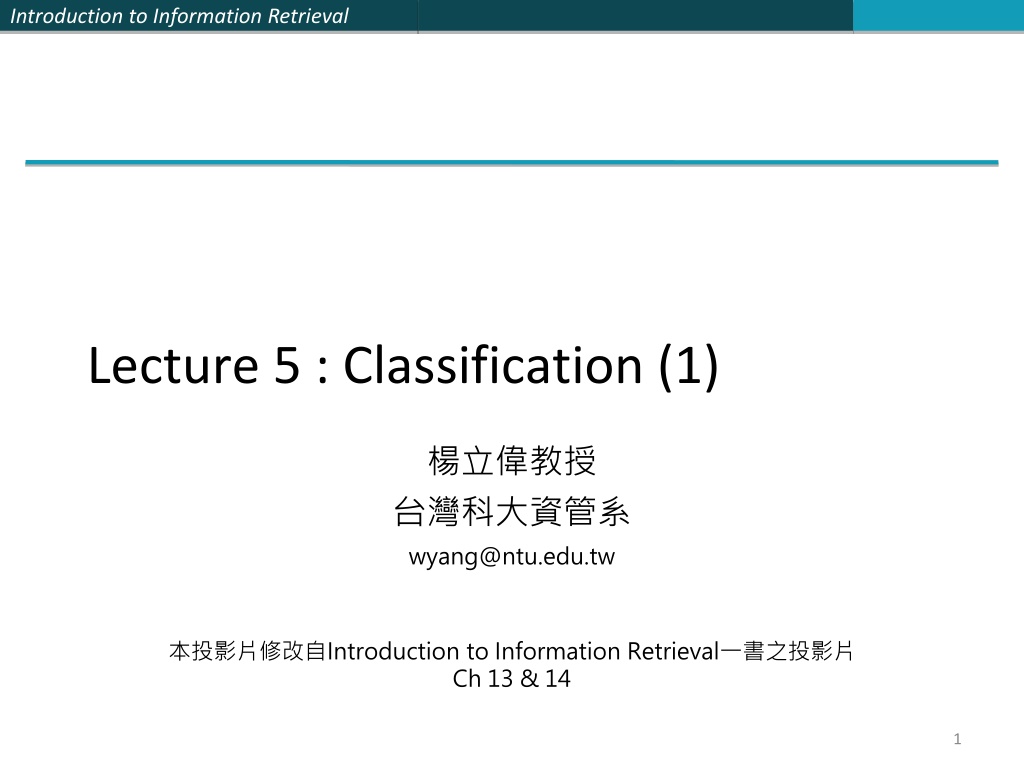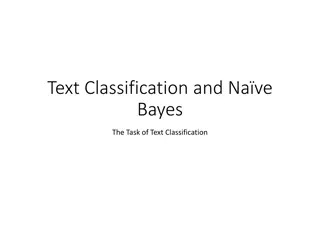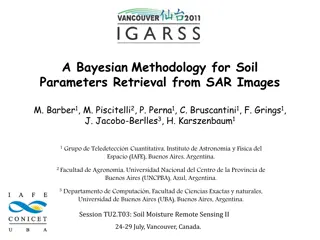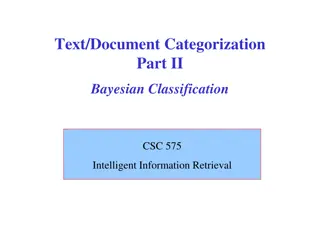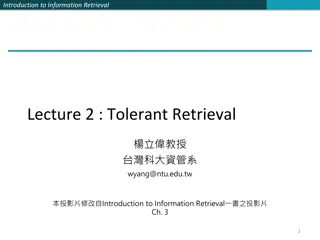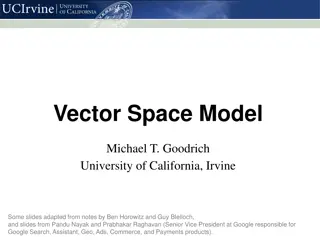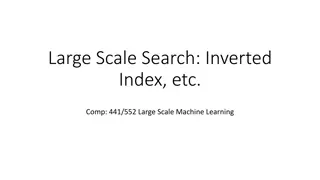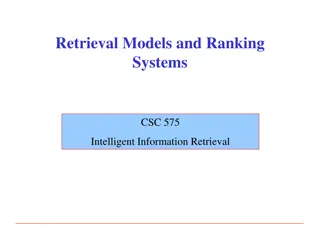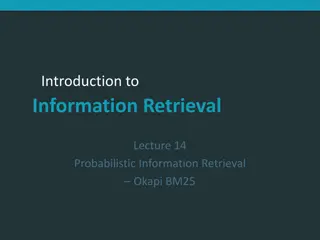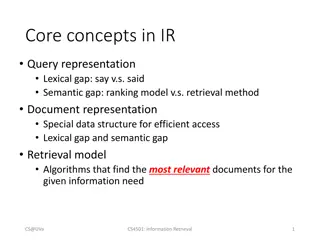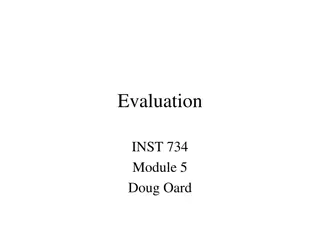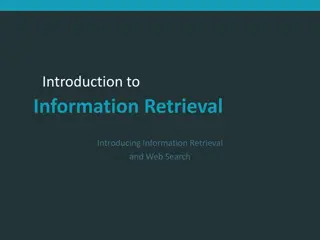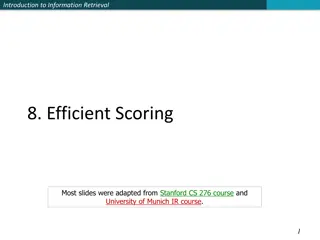Understanding Text Classification in Information Retrieval
This content delves into the concept of text classification in information retrieval, focusing on training classifiers to categorize documents into predefined classes. It discusses the formal definitions, training processes, application testing, topic classification, and provides examples of text classification applications. The material also touches on techniques for detecting and filtering spam emails using automated programs.
- Text classification
- Information retrieval
- Classifier training
- Spam filtering
- Document categorization
Download Presentation

Please find below an Image/Link to download the presentation.
The content on the website is provided AS IS for your information and personal use only. It may not be sold, licensed, or shared on other websites without obtaining consent from the author. Download presentation by click this link. If you encounter any issues during the download, it is possible that the publisher has removed the file from their server.
E N D
Presentation Transcript
Introduction to Information Retrieval Lecture 5 : Classification (1) wyang@ntu.edu.tw Introduction to Information Retrieval Ch 13 & 14 1
Introduction to Information Retrieval Text Classification 2
Introduction to Information Retrieval A text classification task: Email spam filtering From: <takworlld@hotmail.com> Subject: real estate is the only way... gem oalvgkay Anyone can buy real estate with no money down Stop paying rent TODAY ! There is no need to spend hundreds or even thousands for similar courses I am 22 years old and I have already purchased 6 properties using the methods outlined in this truly INCREDIBLE ebook. Change your life NOW ! ================================================= Click Below to order: http://www.wholesaledaily.com/sales/nmd.htm ================================================= How would you write a program that would automatically detect and delete this type of message? 3 3
Introduction to Information Retrieval Formal definition of TC: Training Given: A document space X Documents are represented in this space typically some type of high-dimensional space. A fixed set of classes C = {c1, c2, . . . , cJ} The classes are human-defined for the needs of an application (e.g., relevant vs. nonrelevant). A training set D of labeled documents with each labeled document <d, c> X C Using a learning method or learning algorithm, we then wish to learn a classifier that maps documents to classes: : X C 4 4
Introduction to Information Retrieval Formal definition of TC: Application/Testing Given: a description d X of a document Determine: (d) C, that is, the class that is most appropriate for d 5 5
Introduction to Information Retrieval Topic classification 6 6
Introduction to Information Retrieval Example "planning language proof intelligence" Test Data: (AI) (Programming) (HCI) Classes: Planning Semantics Garb.Coll. Multimedia GUI ML Training Data: learning intelligence algorithm reinforcement network... planning temporal reasoning plan language... programming semantics language proof... garbage collection memory optimization region... ... ...
Introduction to Information Retrieval More examples of TC Applications Labeling ( ) Assign labels to each document : Labels are most often topics such as Yahoo-categories Labels may be language or genres e.g., "finance," "sports," "news>world>asia>business" e.g., English" Chinese" French Labels may be sentiments e.g., "editorials" "movie-reviews" "news Labels may be domain-specific binary e.g., like , hate , neutral e.g., "interesting-to-me" : "not-interesting-to-me e.g., spam : not-spam e.g., contains adult language : doesn t
Introduction to Information Retrieval Classification Methods (1) Manual classification Used by Yahoo, ODP, PubMed Very accurate when job is done by experts Consistent when the problem size and team is small Difficult and expensive to scale need automatic methods for classification : ODP - Open Directory Project
Introduction to Information Retrieval Classification Methods (2) Rule-based systems Google Alerts is an example of rule-based classification Assign category if document contains a given boolean combination of words ( | ) Accuracy is often very high if a rule has been carefully refined over time by a subject expert Building and maintaining these rules is cumbersome and expensive ( | | | | .)
Introduction to Information Retrieval Classification Methods (3) Statistical/Probabilistic systems Text classification as a learning problem (i) Supervised learning of a the classification function and (ii) its application to classifying new documents Examples Naive Bayes (simple, common method) k-Nearest Neighbors (simple, powerful) Support-vector machines (new, more powerful) No free lunch: requires hand-classified training data But data can be built up (and refined) by non-experts 11
Introduction to Information Retrieval Na ve Bayes 12
Introduction to Information Retrieval Overview The Naive Bayes classifier is a probabilistic classifier. Build a generative model that approximates how data is produced Uses prior probability ( ; ) of each category given no information about an item. Categorization produces a posterior probability ( ; ) distribution over the possible categories given a description of an item. :
Introduction to Information Retrieval Posterior probability 20 20 14 6 20 21 9 30 35 15 50 A 20 B 20 P(B|A)=21/35=0.6 P(B|A) = P(A B) / P(A) = 0.42/0.7 = 0.6
Introduction to Information Retrieval Bayes' Rule ( ) = = ( , ) ( | ) ( ) ( | ) ( ) P C X P C X P X P X C P C X C ( | ) ( ) P X C P C = ( | ) P C X ( ) P X P(X) : X 15
Introduction to Information Retrieval Naive Bayes Classifiers (1) Task: Classify a new instance D based on a tuple of attribute values into one of the classes cj C Naive Bayes classification is to find the "best" class (the most likely or maximum a posteriori (MAP) class Cmap ) = , , , D x x nx 1 2 = argmax c j ( | , , , ) c P c x x x 1 2 MAP j n C ( , P , , | ) ( ) P x x x c P c 1 2 n j j = argmax c j ( , , , ) x x x C 1 2 n as P(D) is constant = argmax c j ( , , , | ) ( ) P x x x c P c 1 2 n j j C
Introduction to Information Retrieval Naive Bayes Classifiers (2) P(cj) Can be estimated from the frequency of classes in the training examples. P(x1,x2, ,xn|cj) Could be estimated if a very large number of training examples was available. applying Na ve Bayes Conditional Independence Assumption
Introduction to Information Retrieval Na ve Bayes Assumption Flu X1 X2 sinus X3 X4 fever X5 runnynose cough muscle-ache Conditional Independence Assumption: Assume that the probability of observing the conjunction of attributes is equal to the product of the individual probabilities P(xi|cj). = ( , , | ) ( | ) ( | ) ( | ) P X X C P X C P X C P X C 1 5 1 2 5
Introduction to Information Retrieval Na ve Bayes: Learning From training corpus, extract Vocabulary Calculate required P(cj)and P(xk | cj) For each cj in Cdo docsj subset of documents for which the target class is cj | | ) ( j c P docs j | documents # total | Concatenate all docsj into a single document Textj for each word xkin Vocabulary nk number of occurrences ofxkin Textj + n Smoothing to ( | ) k P x c k j + | | n Vocabulary avoid over-fitting
Introduction to Information Retrieval Na ve Bayes: Classifying positions all word positions in current document which contain tokens found in Vocabulary Return cNB, where positions = argmax ( ) ( | ) c P c P x c NB j i j c C i j ,
Introduction to Information Retrieval Smoothing to avoid over-fitting If a document contains a term x which never appears in the category c, the p(x|c) will always be zero, and the product will be zero, too. to add one smoothing to avoid zeros : n ( | ) k Before P x c k j n + n After ( | ) k P x c k j + | | n Vocabulary 21
Introduction to Information Retrieval Naive Bayes: Training 22 22
Introduction to Information Retrieval Naive Bayes: Testing 23 23
Introduction to Information Retrieval Na ve Bayes : discussion 24
Introduction to Information Retrieval Violation of NB Assumptions Conditional independence VSM Conclusion Naive Bayes can work well even though conditional independence assumptions are badly violated Because classification is about predicting the correct class and not about accurately estimating probabilities. 25
Introduction to Information Retrieval NB with Feature Selection (1) Text collections have a large number of features 10,000 1,000,000 unique words and more Feature ( ) Reduces training time Training time for some methods is quadratic or worse in the number of features Can improve generalization (performance) Eliminates noise features Avoids overfitting
Introduction to Information Retrieval NB with Feature Selection (2) 2 ideas beyond TF-IDF Hypothesis testing statistics: Are we confident that the value of one categorical variable is associated with the value of another Chi-square test Information theory: How much information does the value of one categorical variable give you about the value of another Mutual information They re similar, but 2 measures confidence in association, (based on available statistics), while MI measures extent of association (assuming perfect knowledge of probabilities)
Introduction to Information Retrieval Naive Bayes is not so naive Naive Naive Bayes has won some bakeoffs (e.g., KDD-CUP 97) More robust to nonrelevant features than some more complex learning methods More robust to concept drift (changing of definition of class over time) than some more complex learning methods Better than methods like decision trees when we have many equally important features A good dependable baseline for text classification (but not the best) Optimal if independence assumptions hold (never true for text, but true for some domains) Very fast : Learning with one pass over the data; testing linear in the number of attributes, and document collection size Low storage requirements 28 28
Introduction to Information Retrieval Na ve Bayes : evaluation 29
Introduction to Information Retrieval Evaluation on Reuters 30 30
Introduction to Information Retrieval Example: The Reuters collection 31 31
Introduction to Information Retrieval A Reuters document 32 32
Introduction to Information Retrieval Evaluating classification Evaluation must be done on test data that are independent of the training data (usually a disjoint set of instances). It s easy to get good performance on a test set that was available to the learner during training (e.g., just memorize the test set). Measures: Precision, recall, F1, classification accuracy 33 33
Introduction to Information Retrieval Precision P and recall R P = TP / ( TP + FP) R = TP / ( TP + FN) 34 34
Introduction to Information Retrieval A combined measure: F F1 allows us to trade off precision against recall. This is the harmonic mean of P and R: 35 35
Introduction to Information Retrieval Averaging: Micro vs. Macro We now have an evaluation measure (F1) for one class. But we also want a single number that measures the aggregate performance over all classes in the collection. Macroaveraging Compute F1 for each of the C classes Average these C numbers Microaveraging Compute TP, FP, FN for each of the C classes Sum these C numbers (e.g., all TP to get aggregate TP) Compute F1 for aggregate TP, FP, FN 36 36
Introduction to Information Retrieval Naive Bayes vs. other methods 37 37
Introduction to Information Retrieval Alternative measurement Classification accuracy : c/n n : the total number of test instances c : the number of test instances correctly classified by the system. 38
Introduction to Information Retrieval Case study : WebKB Experiment Classify webpages from CS departments into: student, faculty, course,project Train on ~5,000 hand-labeled web pages Cornell, Washington, U.Texas, Wisconsin Crawl and classify a new site (CMU) Results: Student 180 130 72% Faculty 66 28 42% Person 246 194 79% Project 99 72 73% Course 28 25 89% Departmt 1 1 100% Extracted Correct Accuracy: 39
Introduction to Information Retrieval NB Model Comparison 40
Introduction to Information Retrieval Case study : Apache SpamAssassin Na ve Bayes classifier for spam filtering Widely used in spam filters Classic Naive Bayes superior when appropriately used Many email filters use NB classifiers But also many other things: black hole lists, etc. 42
Introduction to Information Retrieval Na ve Bayes on spam email 43
Introduction to Information Retrieval kNN : K Nearest Neighbors 44
Introduction to Information Retrieval Vector space classification As before, the training set is a set of documents, each labeled with its class. In vector space classification, this set corresponds to a labeled set of points or vectors in the vector space. Premise 1: Documents in the same class form a contiguous region. Premise 2: Documents from different classes don t overlap. We define lines, surfaces, hypersurfaces to divide regions. ( ) 45
Introduction to Information Retrieval Classes in a Vector Space Government Science Arts
Introduction to Information Retrieval Test Document = Government Similarity hypothesis true in general? Government Science Arts
Introduction to Information Retrieval k Nearest Neighbor Classification To classify document d into class c Define k-neighborhood N as k nearest neighbors of d Count number of documents i in N that belong to c Estimate P(c|d) as i/k Choose as class argmaxc P(c|d) [ = majority class] : k ( ) 48
Introduction to Information Retrieval Example: k=6 (6NN) P(science| )? P(Government| )? Government Science Arts
Introduction to Information Retrieval Nearest-Neighbor Learning Algorithm Learning is just storing the representations of the training examples in D. Testing instance x: Compute similarity between x and all examples in D. x Assign x the category of the most similar example in D. x Does not explicitly compute a generalization or category Also called: Case-based learning Memory-based learning Lazy learning 50
